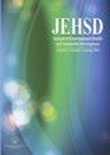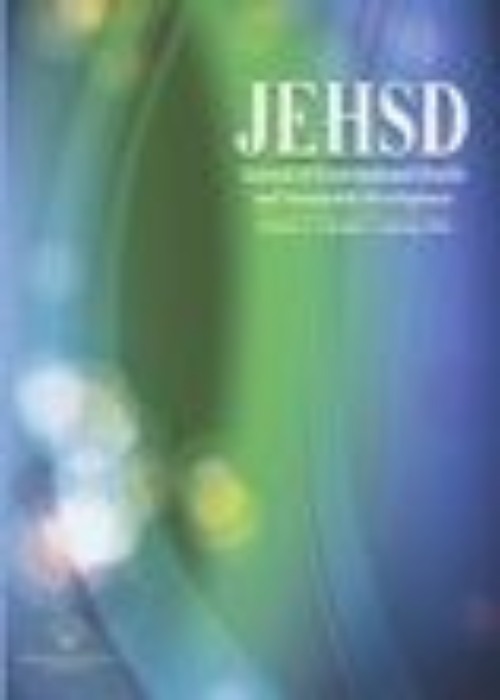فهرست مطالب

Journal of Environmental Health and Sustainable Development
Volume:3 Issue: 1, Mar 2018
- تاریخ انتشار: 1397/01/06
- تعداد عناوین: 8
-
Pages 438-447IntroductionIn order to achieve sustainable development in mining, waste management is an essential requirement. The current study aimed to examine industrial solid waste produced in Golgohar Mining and Industrial Company, which is a well-known iron ore extraction and processing complex.Materials And MethodsThis cross-sectional study was conducted in two phases from March, 2016 through March, 2017. In the first phase, the data related to the production process and quantity/quality of produced wastes were collected through conducting field observations, interviewing production, environmental experts in Golgohar Mining and Industrial Company, and examining the gleaned evidence. In the second phase, the XRF was used to examine the composition of processing tailings following the ISO 9516-1: 2003.ResultsIn total, 16, 19, and 17 types of industrial wastes were respectively identified in the extraction sector, the magnetite processing plant, and the polycom processing plant of Golgohar Mining and Industrial Company and 12, 14, and 12 types of which (in the same order) were recyclable. The ingredients of iron ore processing tailings encompassed quartz, manganese oxide, iron oxides, aluminum oxide, calcium carbonate, sulfur, potassium oxide, sodium oxide, titanium oxide, phosphorus, chromium oxide, and barium oxide. The largest proportion (32.9%) was recorded for quartz in dry tailings.ConclusionIt is essential to pay more attention to recycling in such industries. Improving production processes for retrieve more iron and the use of mineral wastes as raw materials for other industries can reduce the problems associated with such wastes (eg low storage space and environmental problems).Keywords: Golgohar, Industrial Waste, Iron Ore, Mining, Recycling, Tailing
-
Pages 448-453IntroductionDrinking water should be free of any chemical contaminants. One of the important aspects of drinking water pollution is presence of heavy metals that can be hazardous for consumers health. This study was carried out to determine the concentration of heavy metals in urban and rural drinking water networks of Hamadan province in 2016.Materials And MethodsThis study was a descriptive cross-sectional study. In order to investigate the concentration of heavy metals in drinking water resources of the province, a total of 60 samples (38 rural and 22 urban samples) from water distribution networks was taken based on standard methods. After transferring the samples to the laboratory, the elements were measured by polarography and the results were analyzed using Excel software.ResultsThe heavy metals average concentration of Hg, As, Cr (total), Cu, Pb, Cd and Zn in all samples was 0.565, 6.733, 2.045, 11.637, 2.636, 0.031 and 282.596 µg.L-1 respectively. Only 1.67% of samples were contaminated with mercury, 3.33% were contaminated with lead and 8.33% samples were contaminated with arsenic.ConclusionThe results showed that the average concentration of heavy metals measured in all samples of Hamadan province was lower than the maximum allowed in the national and international standards. Apart from the worrying situation of arsenic amount in samples of a small number of villages, it can be concluded that the status of drinking water sources in terms of heavy metals contamination is favorable in Hamadan province, but annually control of arsenic is strongly recommended.Keywords: Drinking Water, Hamadan City, Heavy Metals, Polarography
-
Pages 454-463IntroductionThe groundwater is the main resource of water. This study aimed to investigate water quality variations in the villages of AqQala in a eleven-year period as well as designing and implementing the Water Quality Index (WQI).Materials And MethodsIn order to investigate water quality variations, the data in the villages of AqQala city was collected in an eleven-year period (2005-2015). Also, according to the research objectives, a sample period in year 2015 was carried out. Samples were measured according to the standard method for examination of water and wastewater. In order to calculate the Groundwater Water Quality Index (GWQI), the Iranian Water Quality Index Software (IWQIS) was used.ResultsSome parameters of water quality, including pH, calcium, magnesium and potassium in all sources, were in standard limit. Some of the parameters were higher than the standard limit, which included turbidity, ammonium, phosphate in all sources and sulfate, chloride, sodium, iron and manganese, silicate and alkalinity in some resource. The results measured by the GWQI index in groundwater resources showed that the groundwater source was not with excellent water quality. About 19.3% of sources had poor qualities and the other sources had good qualities.ConclusionThe results of water quality over this period showed that some parameters were increased; which leads to water quality reduction. Therefore, comprehensive management of drinking water resources is essential for people's health.Keywords: Drinking Water, Groundwater, Water Quality
-
Pages 464-471IntroductionHealth-care waste can threaten the health of humans and environment due to dangerous, toxic and pathogenic agents. This study was conducted to investigate the status of disinfection equipment in Tehran hospitals as well as their health and economic evaluation in 2016.Materials And MethodsIn this research, 27 hospitals in Tehran that equipped with disinfection equipment were selected randomly. For health evaluation of chemclave, autoclave and hydroclave disinfection equipment was used respectively form the Bacillus Atrophies Indicator, a plastic vial of stearothermophilus and a vial of syringe and for economic evaluation a standard checklist was used. Finally, Fisher's exact test was used to analyze the data.ResultsThe results of health evaluation showed that the removal rate of indicator organisms in hydroclave, autoclave and chemclave disinfection equipment were 100%, 86.7% and 75%, respectively. The results of the economic evaluation showed that the investment cost of the Autoclave and Hydroclave were over 100 thousand dollars and the chemiclave was below 100 thousand dollars (P = 0.002). The most reduction of waste volume after disinfection was related to hydroclave and autoclave devices (P ≤ 0.001). The highest amount of odor production was in the chemiclave and the minimal was in the autoclave and hydrocollo method (P = 0.003). Also, hydroclave and autoclave were the environmentally friendly methods and chemiclave was not (P = 0.004).ConclusionsBy comparing health and economical assessments, the autoclave disinfection device at the moment, if resolved the grinding problem, is the best way for health-care waste disinfection.Keywords: Economic Evaluation, Health-care Waste, Waste Disinfection
-
Pages 472-480IntroductionLeachate is a liquid coming out of accumulated wet wastes which contains several chemical and dangerous elements. Furthermore, it causes the aquatic ecosystem contamination. The purpose of this study is to give an indication of the effects of Tonekabon landfill on the surface water, so evaluating the amount of leachate polluting in surface waters was investigated.Materials And MethodsIn the current study, after 4 sampling periods at 4 stations, parameters of pollutants including BOD5, COD, TSS, TDS, pH, and EC at different stations and in different seasons were investigated and analyzed.ResultsThe results revealed that there was no significant difference between 4 stations in pH mean values, while values of other parameters were significantly different at different stations. Based on Duncan's test, the station of 3 and 4 were significantly different in the same group, and the stations of 1 and 2 were each in separate groups. On the other hand, an examination of the difference in data mean based on sampling season shows that there is a significant difference between the mean values of pH between summer and spring, while in other parameters there is no significant difference.ConclusionThis landfill is important due to its location in the forest area near the rural and agricultural centers. The results showed that leachate could be transported to farther places in order to prevent soil and aquatic ecosystem Contamination.Keywords: Landfill, Leachate, Tonekabon City, Water Quality
-
Pages 481-487IntroductionFluoride (F) and its compounds are widely used in industries in which fluoride overdose leads to various detrimental diseases. In this study the effect of NaOH-modified Eucalyptus leaves on fluoride removal from aqueous solutions as a natural adsorbent was investigated.Materials And MethodsThe focus of this study was on the effects of parameters such as pH (2-12), initial concentration (5-30 mg/L), adsorbent dose (0.1-1 g/L) and temperature (25-45 0C). Fluoride residual was measured using the SPADNS method by a DR 5000 spectrophotometer.ResultsThe maximum adsorption capacity, at pH 2 was found to be 97 mg F/g with an adsorbent dosage of 0.5 g/L and an initial fluoride concentration of 20 mg/L. The adsorption equilibrium and kinetic data were in good agreement with Langmuir Model (R2 = 0.967) with qmax = 298 mg/g and pseudo-second order reaction (R2 = 0.999).ConclusionBased on the results, NaOH-modified eucalyptus leaves were found to be able to remove fluoride from aqueous environments with good removal efficiency and adsorption capacity.Keywords: Eucalyptus, Fluoride Removal, Natural Adsorbent


